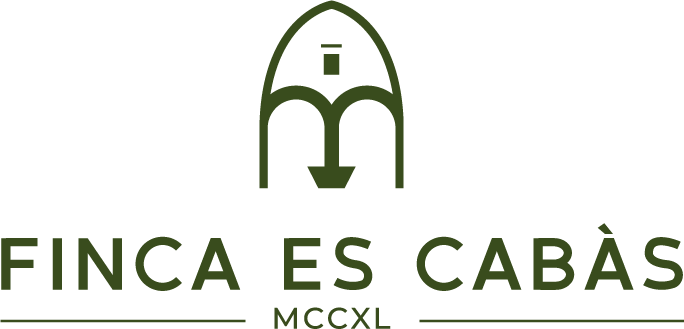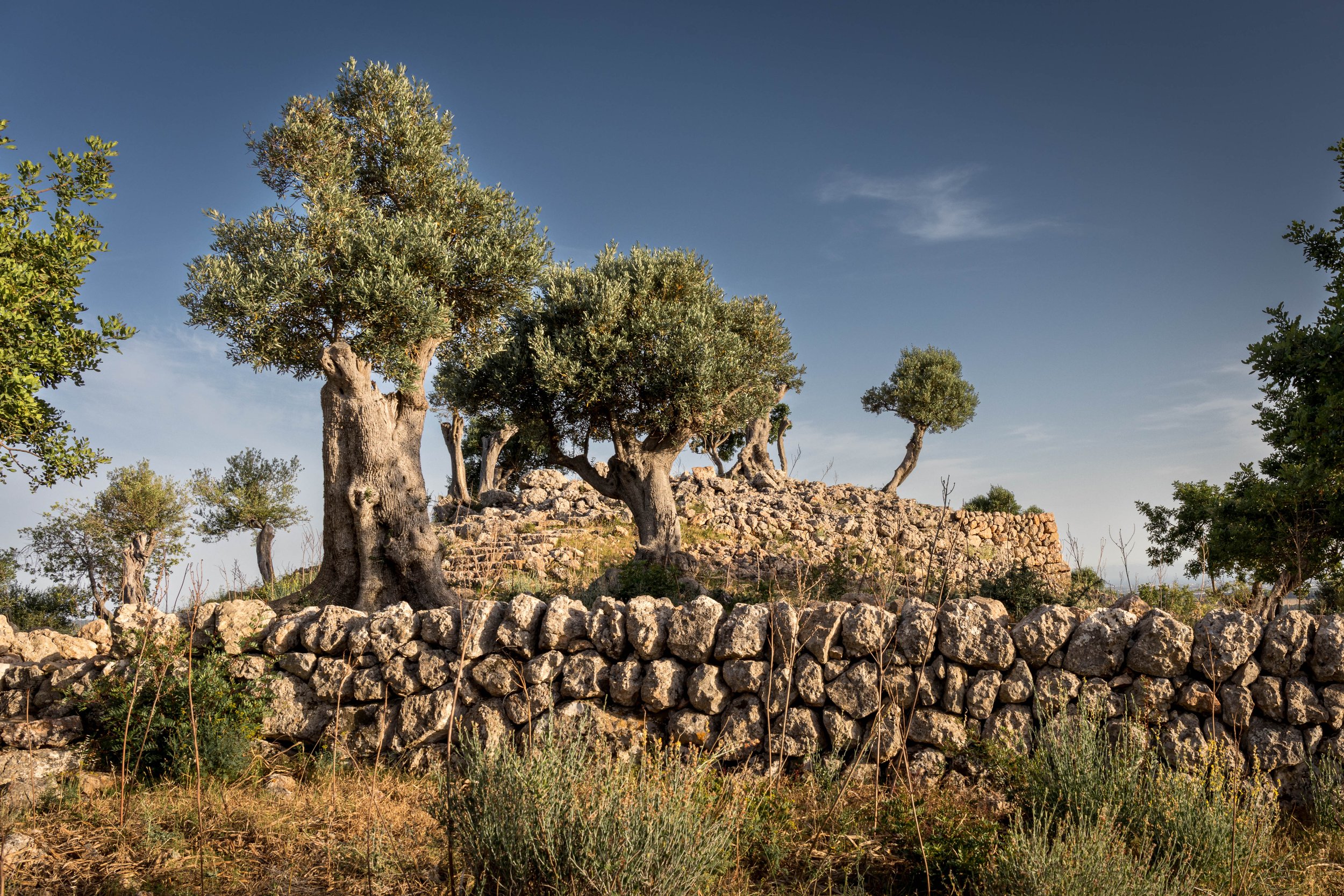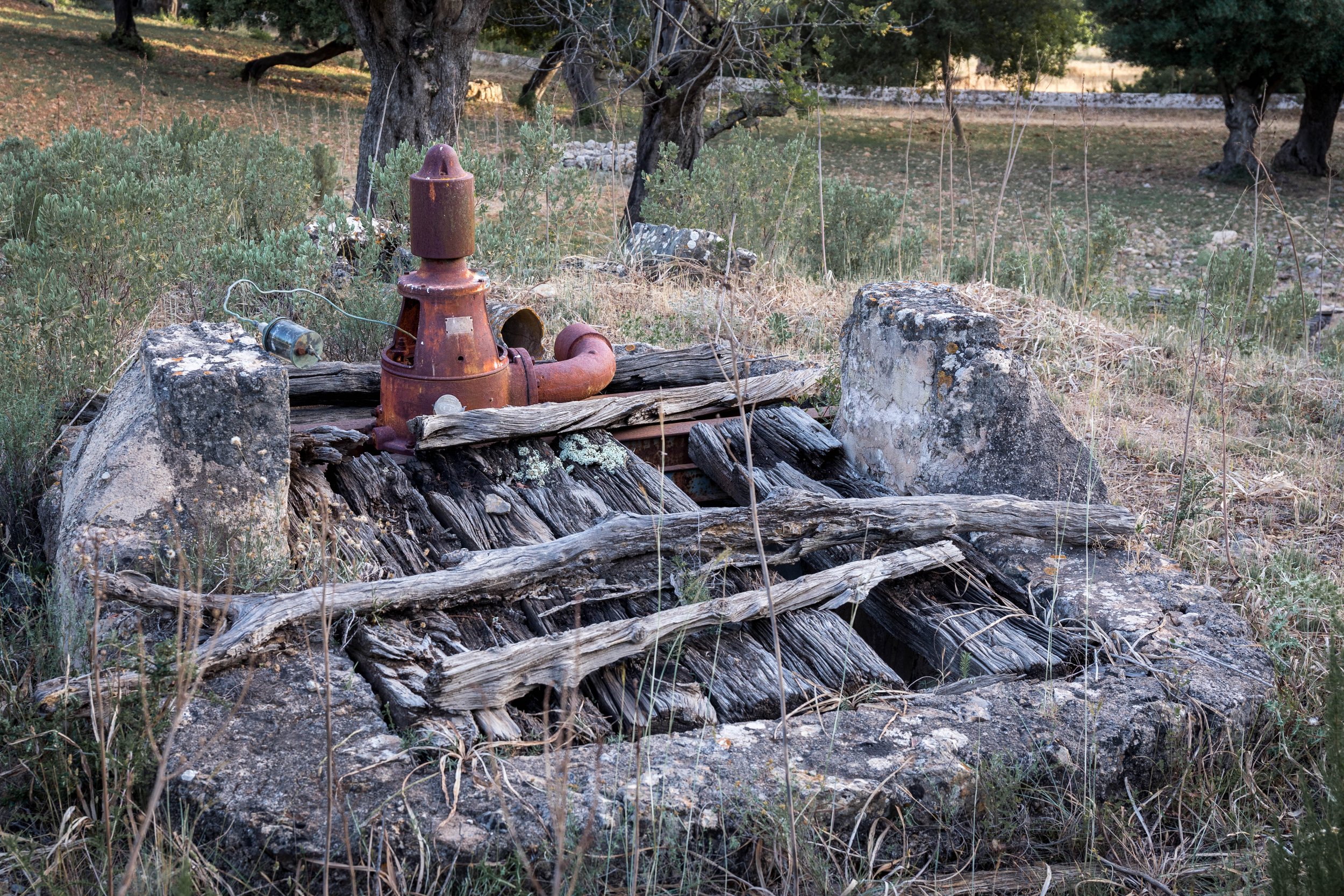The history of Finca Es Cabàs dates back to prehistoric times. The Talayotic period in Mallorca was recorded with the construction of the Talayotic Mound located on the top of the hill called Sa Talaia. This monument, called Es Claper des Doblers, dates from 3,500-2,500 BC and was used as a place for ceremonies, a funeral monument and a lookout point.
In addition to this place, considered sacred by the first settlers, and catalogued as BIC (Bien de Interés Cultural), there are also other BICs such as the Cova des Moro, inhabited at the same time, and some quarries from where the "cerumina" was extracted, a material used to varnish and give consistency to the ceramics produced in the whole valley, examples of which can be seen in the National Archaeological Museum in Madrid.
View of the talayotic monument Es Claper des Doblers located on the hill Sa Talaia of the estate.
There is no evidence of Roman occupation, after that era, although some of the roads that run through the estate could date back to that time. But there is a valuable legacy of the Muslim period dating from the ninth century, until 1229 when the conquest of Mallorca by James I of Aragon began. During the Muslim period the first settlement of the present house appears. The first water well was created, a waterwheel (sínia) was built and the first known irrigation system, with a ditch(qanat) that supplied the house and its orchard, the so-called "alquería".
The first known owner and promoter of the agricultural activity, and of the current settlement, was Abrahim Alfeluz (Abrahim "of great wealth"). At that time, in the 13th century, Finca Es Cabàs was known as Alquería Abrahim Alfeluz or Rahal Cahuas. According to prestigious archaeologists and historians, there are two versions of the toponymic origin of Es Cabàs. Some defend the origin of Cabàs as coming from qawda which means "difficult ascent to the mountain". Others defend the origin from the word cahuas which means "vineyard area". It is worth mentioning that the fields at the entrance to the estate, on both sides of the road, currently populated with almond and carob trees, were once vineyards (the toponym Tanca de sa vinyota is recorded) until a plague that devastated the island during the 19th century killed them and a change of cultivation was made. The nickname Rahal is translated to our days as "Rafal", synonym of "finca", used in Mallorca in a generalized way.
Photograph of the place where the first waterwheel (sínia) was built.
After the Muslim period of Finca Es Cabàs, the period in which the current settlement of our agritourism began, the property passed into Christian hands. The first records, since the reconquest of Mallorca in 1229, date from 1240, where Pere Sagristà and Guillem Pons appear as owners. Later the property was reunified, after several new divisions, with the purchase of all the land by Ramón de Berga. After this owner, several fragmentations followed. One of the families that deserves to be mentioned, among the successive acquisitions, is the Eimerit family, since in the 14th century they gave their name to the highest peak of the estate and current border with the Commune of Bunyola to the north (Puig de n'Eimerit, 666 m).
In the 15th century the property was definitively reunified after the purchase by the Sureda family, future Marquises of Vivot, between 1491 and 1521. This family also acquired in 1482 the adjoining estate Son Sureda, located on the other side of the road, in front of Es Cabàs. On June 30, 1898 the Marquis of Vivot, of the Sureda family, sold Es Cabàs and Son Sureda to Manuel Salas Palmer, my great-great-grandfather, the first owner of our family saga. After his unexpected death, the same year of the purchase, both properties were inherited by his son Manuel Salas Sureda (1880-1942) who, in my opinion, together with the Arab contribution at the time of Abrahim Alfeluz, was the driving force behind a new agricultural reform of great importance and legacy. He built terraces in areas at risk of erosion due to rainfall, studying on the ground the advance of water during storms. He made extensive almond and carob tree plantations, and changed the model of agricultural management. Until then, since the Reconquest, the crops were exploited by tenant farmers who were dedicated to managing agricultural production, livestock and forestry. My great-grandfather directly assumed this function. As a testimony of his work remain the almond and carob tree fields, the countless terraces, a cistern for rainwater collection and cattle watering, a shed with fireplace and cistern for the peasants to rest during the working day and the plan of the farm that is preserved in the reception of the agritourism today.
At the end of the 19th century we already find archives in the Die Balearen of Archduke Luis Salvador of Austria, where he comments that Es Cabàs was the largest property in the municipality of Santa María with an area of olive groves of 194 quarterades (each quarterada is equivalent to 7,103 square meters), 183 of carob and almond trees, 19 of vineyards, 63 of dry pastures and 343 of forest and undergrowth.
After that time, Amanda Salas Garau, my grandmother, inherited the estate. She kept her father's agricultural exploitation, together with sheep farming, but agriculture was already in decline due to its low profitability. The property of Son Sureda passed to his brother Fernando Salas Garau. And his other four brothers inherited the rest of the estates that their father was buying during several years thanks to the benefits of his businesses and because they were investments with good profitability among which Xorrigo, Solleric, Son Berga and Son Patx are worth mentioning, among others.
The industrial revolution led to the cessation of the activity of the olive mill(tafona), where olive oil was produced. Olive trees were no longer cultivated, gradually abandoning the centuries-old trees that date back to Arab times, continuing only with the cultivation of almond and carob trees, in addition to dry pastures. Amanda Salas reformed the house by converting the barns, already in disuse, located on the upper floor, into a habitable and conditioned space to spend the summer months. Until 1959 the building only had outbuildings where the family of farmers in charge of the farm and some employees who worked in the fields, as well as the shepherd, lived. Until then, only Son Sureda had rooms for the owners.
Later, Ana Fortuny Salas, my mother, was the first heiress of Finca Es Cabàs who decided to live there and was the one who designed its current gardens. But every time agriculture and livestock were more and more precarious and insufficient for the maintenance of Es Cabàs.
Since 2010, my wife María Obrador Planas and I, a doctor by profession and with great attachment to this land and my roots, decided to live here to try to recover the splendor of this romantic and captivating place by initiating our family and life project. We recovered the centenary olive grove, planted vines, fruit trees, fig trees, carob and almond trees, and little by little, we restored the ethnological elements of the estate. The so-called Claper des Doblers, the lime kilns from which the material was extracted for the construction and whitewashing of the houses of the village (until the beginning of the 20th century), the coal bunkers(sitges) where the coal used in the kitchens of all the homes was produced before the use of electricity. In addition, we carry out a forestry project for the maintenance of forests and another for the recovery and conservation of native fauna such as the red kite, the black vulture(voltor negre), booted eagle, black-headed turtle and native goat(boc balear) among other species.
We have also reintroduced endangered domestic species such as the Mallorcan donkey and the Mallorcan cow. Both species are useful for cleaning our fields and forests. We also collaborate with the company MELVICI dedicated to beekeeping, which supplies us with honey from our own bees and is an indispensable tool for pollination of our crops. At the same time, we have recovered the breeding of the Mallorcan black pig(porc negre), which provides us with our own artisan production of the island's prized traditional sausages. We also cooperate with the Macià Batle winery for the production of our wine and with the Son Catiu oil mill for the production of our own virgin olive oil.
Currently, we are working on the creation of a photovoltaic park for energy self-sufficiency. But we knew that although the present was motivating, we would not be able to ensure the viability of Finca Es Cabàs in the future. We had to go a step further to be able to realize our dream without it becoming pure utopia. Tourism was necessary for the sustainability of the farm and to be able to spread our values by sharing this experience.
Thanks to all of you we are succeeding. Thank you for making, between all of us, that our project continues, recovering a small part of the essence of this wonderful Mediterranean island.
-Diego Puig Fortuny, May 15, 2021


